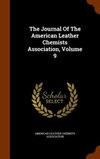Tanning with Aluminum-Gallic Acid Complex
IF 0.5
4区 工程技术
Q4 CHEMISTRY, APPLIED
Journal of The American Leather Chemists Association
Pub Date : 2021-03-01
DOI:10.34314/jalca.v116i3.4250
引用次数: 1
Abstract
To figure out how polyphenol compounds with a low molecular weight helped in aluminum tannage, a complex of gallic acid and aluminum as well as its application to the tanning of hide powder was studied in this paper. Precipitation points of aluminum chloride solution with different concentrations of gallic acid were measured to guide the basification in hide powder tannage. UV-Visible spectra showed that gallic acid and aluminum would form soluble complexes in aqueous solution and the complexation reaction was pH reliable. Through stoichiometry studies, generations of the 1:2 complex under pH 4.0 and 2:3 complex under pH 4.5 were discovered. Results of stoichiometry studies and Fourier Transform Infrared Spectroscopy (FTIR) spectra confirmed that aluminum-gallic acid complex played the role of links which connected collagen molecules rather than gallic acid or aluminum forming individual bridges with collagen. According to the results of differential scanning calorimetry (DSC) and thermal gravity analysis (TGA), denaturation temperature (Td) of hide powder tanned with different methods, such as aluminum, gallic acid-aluminum combination or aluminum-gallic acid complex, was 76.1°, 82.8° and 85.5°C respectively, and the initial decomposition temperature for the aluminum-gallic acid complex tannage was 300.7°C, also higher than those for another two methods. Furthermore, the results of inductive coupled plasma emission spectroscopy (ICP) showed that after washing for 12 h, the Al2O3 content in hide powder tanned with complex could be maintained at 93.42% of that in unwashed samples, which was the highest among three tanning methods.用铝-没食子酸配合物制革
为了解低分子量多酚类化合物对铝鞣的促进作用,本文研究了没食子酸与铝的配合物及其在兽皮粉鞣中的应用。测定了不同没食子酸浓度下氯化铝溶液的沉淀点,以指导皮革粉鞣制过程中的碱化。紫外可见光谱结果表明,没食子酸与铝在水溶液中形成可溶配合物,配合反应pH可靠。通过化学计量学研究,发现了pH 4.0条件下的1:2配合物和pH 4.5条件下的2:3配合物。化学计量学研究和傅里叶变换红外光谱(FTIR)结果证实,铝-没食子酸配合物起连接胶原分子的作用,而不是没食子酸或铝与胶原形成单独的桥梁。差示扫描量热法(DSC)和热重分析(TGA)结果表明,铝、没食子酸-铝复合或铝-没食子酸络合鞣制兽皮粉的变性温度(Td)分别为76.1°、82.8°和85.5°C,铝-没食子酸络合鞣制兽皮粉的初始分解温度为300.7°C,也高于另外两种方法鞣制兽皮粉的初始分解温度。电感耦合等离子体发射光谱(ICP)结果表明,经过12 h的洗涤后,配合物鞣制的皮革粉中Al2O3的含量保持在未洗涤样品的93.42%,是三种鞣制方法中最高的。
本文章由计算机程序翻译,如有差异,请以英文原文为准。
求助全文
约1分钟内获得全文
求助全文
来源期刊

Journal of The American Leather Chemists Association
工程技术-材料科学:纺织
CiteScore
1.30
自引率
33.30%
发文量
29
审稿时长
3 months
期刊介绍:
The Journal of the American Leather Chemists Association publishes manuscripts on all aspects of leather science, engineering, technology, and economics, and will consider related subjects that address concerns of the industry. Examples: hide/skin quality or utilization, leather production methods/equipment, tanning materials/leather chemicals, new and improved leathers, collagen studies, leather by-products, impacts of changes in leather products industries, process efficiency, sustainability, regulatory, safety, environmental, tannery waste management and industry economics.
 求助内容:
求助内容: 应助结果提醒方式:
应助结果提醒方式:


